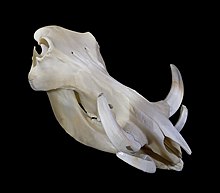Warthog
| Warthog | ||||||||||||
|---|---|---|---|---|---|---|---|---|---|---|---|---|

Warthog |
||||||||||||
| Systematics | ||||||||||||
|
||||||||||||
| Scientific name | ||||||||||||
| Phacochoerus africanus | ||||||||||||
| ( Gmelin , 1788) |

The warthog ( Phacochoerus africanus ) is a species of mammal from the family of real pigs (Suidae) native to large parts of Africa . Together with the desert warthog , it forms the genus of warthogs .
features

At first glance, warthogs resemble a somewhat flatter wild boar with a slightly too large, bizarre head. Above all, the four paired warts on the head and the semicircular, up to 30 cm long, curved tusks (the canines of the upper jaw) contribute to this impression. The lower canines are also elongated; they are shorter but sharper. The warts, which can be very large especially in old males, are pure skin structures without a bony or muscle basis that are already created in the embryo. The short neck has a kind of dewlap .
The usually gray fur of the warthogs is much less thick than that of the Central European wild boars due to their warmer home. Warthogs have a long mane of neck and back that straighten up in the event of danger, and a tasseled tail, which they set up when fleeing or attacking - this behavior gives them the nickname “Radio Africa”. These animals reach a head body length of 90 to 150 cm, the tail becomes 25 to 50 cm long and the shoulder height is 64 to 85 cm. The weight is between 50 and 150 kg, with the males being heavier than the females.
distribution and habitat
Warthogs are almost all over Africa the south Sahara widespread. Their distribution area extends from southern Mauritania and Senegal to Ethiopia and south to Namibia and South Africa . Their habitat are open areas, preferably in savannas and sparse forests.
Way of life
Unlike most other pig species, warthogs are diurnal, but rest in the bushes or under trees during the midday heat. At night they hide in rock holes, old termite burrows and, with preference, in the burrows of the aardvark , which foraging at night.
These pigs live in groups of four to 16 animals, which are usually made up of several females with their offspring. Young males also form groups, while adult boars mostly live solitary. Several groups and individual animals form a large group. The territories of several groups within a large group overlap, sometimes burrows and other resources are also used jointly.
food
Warthogs are omnivores, but they mainly eat plant-based foods. When picking up grasses, they lower themselves on their wrists and push themselves forward in this position. With their snouts and tusks they rummage through the ground in search of roots and tubers. Berries, tree bark and occasionally carrion complete the menu.
Predators
Adult warthogs are hunted by lions , spotted hyenas , leopards and African wild dogs , but not by cheetahs. The pigs can react to this with early enemy detection thanks to the position of the eyes high on the head and at top speeds of around 50 km / h. Even in direct confrontations, they know how to defend themselves with their teeth as weapons, which, if successful, also has a deterrent effect. Another predator in water is the Nile crocodile .
Reproduction
After a gestation period of around 150 to 175 days, the female gives birth to one to eight (usually two or three) young animals. The births usually occur in the dry season, around four to five months after the end of the rainy season. At 50 days the young accompany their mother, at around five months they are weaned. The males leave their mother around 15 months old, the females stay longer, often joining the mother's group. Sexual maturity occurs at around 18 to 21 months. In the wild, their life expectancy is 7 to 11 years, in human care these animals can live up to 20 years.
Warthogs and people
On the one hand, warthogs are considered pests that are hunted in some places because they devastate fields and plantations with their burial activity. On the other hand, they are hunted for their meat. Overall, the species is not yet threatened, even if it has become rare in some areas. Only a subspecies, the Eritrea Warzenschwein ( phacochoerus aeliani africanus ), which occurs only in Eritrea and Djibouti, is of the IUCN as endangered ( endangered ) listed.
literature
- Ronald M. Nowak: Walker's Mammals of the World . Johns Hopkins University Press, Baltimore 1999. ISBN 0-8018-5789-9 .
- DE Wilson & DM Reeder: Mammal Species of the World . Johns Hopkins University Press, 2005. ISBN 0-8018-8221-4 .
Web links
- Video
- Phacochoerus africanus in the endangered Red List species the IUCN 2006. Posted by: Pigs & peccaries Specialist Group, 1996. Retrieved on 12 May, 2006.




